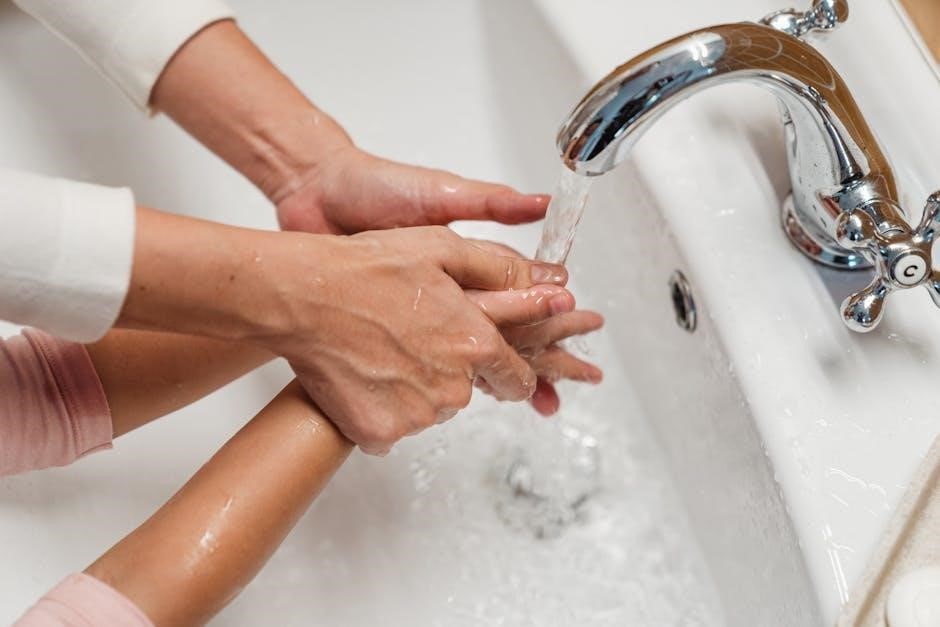The ISSA Cleaning Times PDF is a 17-page guide offering insights into cleaning services, health, and safety protocols․ It serves as a valuable resource for cleaning professionals, providing practical tips on bidding commercial jobs and calculating cleaning rates․ This comprehensive document is designed to enhance efficiency, sustainability, and professionalism in the cleaning industry․
Overview of ISSA and Its Role in the Cleaning Industry
The International Sanitary Supply Association (ISSA) is a global leader in advancing the cleaning industry․ ISSA provides education, standards, and resources to professionals, focusing on health, safety, and sustainability․ Its publications, like the ISSA Cleaning Times PDF, offer practical guidelines and best practices․ ISSA’s role extends to advocacy, ensuring the industry evolves with innovative solutions and adheres to high standards․ By fostering professionalism and efficiency, ISSA supports businesses in maintaining clean, safe environments, making it a trusted authority for cleaning professionals worldwide․
Significance of the Cleaning Times PDF
The ISSA Cleaning Times PDF is a vital resource for cleaning professionals, providing detailed schedules and protocols for maintaining hygiene and safety․ It offers practical insights into cleaning frequencies, equipment maintenance, and staff training, ensuring efficient operations․ The document emphasizes health and safety standards, making it essential for industries requiring high cleanliness levels․ By following its guidelines, businesses can reduce costs, enhance efficiency, and adopt sustainable practices․ This PDF serves as a comprehensive guide, helping organizations meet evolving cleaning standards and maintain professional excellence in their operations․
Historical Context and Evolution of Cleaning Standards
The ISSA Cleaning Times PDF reflects the evolution of cleaning standards, tracing advancements from basic hygiene practices to sophisticated, science-backed protocols․ Historically, cleaning standards were often rudimentary, focusing on visible cleanliness․ Over time, the industry adopted more rigorous methodologies, driven by health concerns, technological advancements, and regulatory requirements․ ISSA, established in 1923, has been instrumental in shaping these standards, integrating innovations like sanitization techniques and sustainable practices․ The document highlights how modern cleaning standards prioritize not only cleanliness but also environmental impact and worker safety, ensuring a holistic approach to maintaining hygienic environments across industries․

Structure and Content of ISSA Cleaning Times PDF

The document is a 17-page guide providing detailed cleaning schedules for equipment like cutting boards and commercial kitchens․ It includes health and safety tips, practical advice on bidding jobs, and resources for calculating cleaning rates, ensuring a comprehensive approach to professional cleaning practices․
General Overview of the Document
The ISSA Cleaning Times PDF serves as a comprehensive guide for cleaning professionals, offering standardized practices and insights to enhance efficiency and effectiveness․ It provides a clear layout, making it easy to navigate through various sections tailored for different cleaning scenarios․ The document emphasizes consistency, safety, and sustainability, ensuring that cleaning protocols align with industry standards․ Designed for both newcomers and experienced professionals, it offers practical advice, checklists, and best practices to streamline operations․ Whether for commercial or industrial settings, the guide is a valuable resource for maintaining high-quality cleaning outcomes while adapting to evolving industry demands and challenges․
Key Sections and Chapters
The ISSA Cleaning Times PDF is organized into distinct sections, each addressing critical aspects of cleaning operations․ Key chapters include Cleaning Standards and Frequencies , detailing optimal schedules for different surfaces and areas․ Another section focuses on Equipment Maintenance , providing guidelines for upkeep and sanitization․ Additionally, chapters on Staff Training emphasize professional development and efficiency․ The document also covers Health and Safety Protocols and Sustainability Practices , ensuring environmentally responsible cleaning methods․ These sections collectively provide a roadmap for implementing effective, standardized cleaning strategies across various industries, aligning with ISSA’s commitment to excellence and innovation in the field․
Cleaning Frequencies and Schedules
The ISSA Cleaning Times PDF provides detailed cleaning frequencies and schedules tailored to different environments and surfaces․ High-traffic areas, such as restrooms and entryways, require daily cleaning, while low-traffic zones may need weekly attention․ The document outlines recommended schedules for tasks like floor cleaning, surface disinfection, and waste removal․ It also offers adjustable frameworks to accommodate varying foot traffic, usage patterns, and industry-specific needs․ This section ensures consistency and efficiency, helping organizations maintain cleanliness without over- or under-cleaning, aligning with both health standards and operational demands․
Equipment Maintenance and Sanitation Practices
The ISSA Cleaning Times PDF emphasizes the importance of proper equipment maintenance and sanitation to ensure hygiene and efficiency․ Regular cleaning and disinfection of tools and machinery are stressed to prevent contamination․ The document provides guidelines for maintaining equipment longevity, including routine checks and timely repairs․ Sanitation practices are detailed, such as using approved cleaning agents and following proper protocols․ Additionally, it highlights the need for organized storage to protect equipment from damage․ These practices are crucial for maintaining a safe and effective cleaning environment, reducing the risk of cross-contamination, and ensuring optimal performance of cleaning operations across industries․ Proper maintenance also extends equipment lifespan, reducing operational costs over time․
Staff Training and Professional Development
The ISSA Cleaning Times PDF underscores the critical role of staff training and professional development in achieving high cleaning standards․ It provides detailed guidance on training programs to ensure consistency, safety, and efficiency․ The document highlights the importance of educating staff on proper cleaning techniques, equipment usage, and safety protocols․ Additionally, it emphasizes ongoing development through certifications, workshops, and upskilling to keep pace with industry advancements․ Well-trained staff are better equipped to handle diverse cleaning challenges, ensuring superior results and compliance with health regulations․ Continuous learning fosters a culture of excellence, enabling teams to adapt to evolving standards and technologies in the cleaning industry․
Best Practices and Tips from ISSA Cleaning Times PDF
ISSA Cleaning Times PDF offers actionable insights, emphasizing efficient cleaning methods, sustainable practices, and adherence to safety standards to enhance overall cleaning operations and outcomes effectively․
Time Management for Efficient Cleaning
Effective time management is crucial for maximizing cleaning efficiency․ The ISSA Cleaning Times PDF suggests prioritizing tasks based on urgency and importance, allowing for a structured approach․ Implementing time-blocking techniques can help allocate specific durations to different cleaning activities, ensuring thoroughness without overextending resources․ Additionally, leveraging technology, such as scheduling software, can optimize cleaning workflows and reduce downtime․ By focusing on high-impact areas and minimizing distractions, cleaning teams can achieve more within set timelines․ Regular reviews of cleaning schedules also help in identifying inefficiencies and adjusting routines for better productivity․ This strategic approach ensures that cleaning operations are both efficient and effective․
Cost-Effective Cleaning Solutions
The ISSA Cleaning Times PDF emphasizes several cost-effective cleaning solutions to enhance operational efficiency without compromising quality․ One key strategy is optimizing inventory management by purchasing cleaning supplies in bulk, which reduces procurement costs․ Additionally, ISSA recommends using multi-purpose cleaning products that can handle various surfaces, minimizing the need for specialized cleaners․ Energy-efficient equipment and practices, such as using low-flow devices and optimizing water usage, contribute to long-term savings․ Regular maintenance of cleaning tools extends their lifespan, reducing replacement expenses․ ISSA also suggests implementing staff training programs that focus on efficient techniques, reducing labor costs and improving overall productivity; These practical tips help organizations maintain high standards while controlling expenses․
Health and Safety Protocols
The ISSA Cleaning Times PDF highlights critical health and safety protocols to ensure a safe working environment․ It emphasizes the use of personal protective equipment (PPE), such as gloves and masks, to prevent exposure to harmful chemicals․ Proper ventilation in cleaning areas is stressed to reduce inhalation risks․ The guide also outlines safe handling and storage of cleaning agents, with clear labeling and secure storage recommendations․ Emergency response plans, including spill management and first aid, are emphasized․ Regular training for staff on hazard identification and safety procedures is encouraged to minimize accidents․ Adhering to these protocols helps protect both workers and facility occupants from potential health risks․
Environmental Considerations and Sustainability
The ISSA Cleaning Times PDF underscores the importance of environmental sustainability in cleaning practices․ It advocates for the use of eco-friendly cleaning products, such as biodegradable detergents and non-toxic chemicals, to minimize environmental impact․ The guide emphasizes waste reduction strategies, including recycling programs and proper disposal of hazardous materials․ Energy-efficient equipment and water-conserving techniques are also recommended to promote sustainability․ Additionally, the PDF highlights the adoption of green cleaning certifications, such as Green Seal or EPA Safer Choice, to ensure compliance with environmental standards․ By integrating these practices, businesses can reduce their ecological footprint while maintaining effective cleaning protocols․
Implementation Strategies for ISSA Cleaning Times PDF
Adapt guidelines to specific business needs, ensuring staff training and technology integration․ Regularly monitor and adjust cleaning schedules for optimal efficiency and effectiveness in operations․
Integrating the Guidelines into Business Operations
Align ISSA Cleaning Times PDF guidelines with your business objectives to enhance operational efficiency․ Start by assessing current cleaning practices and identifying areas for improvement․ Develop a tailored action plan that outlines specific steps for implementation, ensuring all departments are involved․ Communicate the importance of adherence to staff and provide necessary training․ Establish a feedback loop to monitor progress and address challenges promptly․ Regularly review and update protocols to reflect changing business needs and industry standards․ By integrating these guidelines, businesses can maintain a cleaner, safer, and more productive environment while fostering a culture of continuous improvement and accountability․
Customizing Cleaning Schedules for Specific Industries

Adapting ISSA Cleaning Times PDF guidelines to meet industry-specific needs is crucial for effective cleaning․ For healthcare facilities, prioritize high-touch areas and infection control․ In retail, focus on customer-facing spaces and peak traffic times․ Schools require frequent cleaning of classrooms and common areas to prevent germ spread․ Hospitality settings benefit from enhanced sanitation in guest rooms and public spaces․ Tailor schedules to align with operational hours, seasonal demands, and unique industry challenges․ This ensures cleaning efforts are targeted, efficient, and aligned with the specific requirements of each sector, while maintaining high standards of cleanliness and safety․ Customization enhances overall effectiveness and adaptability․
Using Technology to Enhance Cleaning Efficiency
Integrating advanced technologies, as highlighted in the ISSA Cleaning Times PDF, significantly boosts cleaning efficiency․ Automated cleaning equipment, such as robotic vacuums and floor scrubbers, reduces manual labor and ensures consistent results․ IoT-enabled sensors monitor cleanliness levels in real-time, optimizing schedules․ Software solutions streamline task management, allowing teams to track progress and adjust routines dynamically․ Data analytics provide insights to identify trends and improve resource allocation․ Additionally, training staff on technology use ensures seamless adoption; These tools not only enhance productivity but also contribute to sustainable practices, aligning with modern cleaning standards and industry demands for innovation and precision in maintenance operations․

Monitoring and Evaluating Cleaning Effectiveness
Monitoring and evaluating cleaning effectiveness is crucial for maintaining high standards, as emphasized in the ISSA Cleaning Times PDF․ Regular inspections using checklists and performance metrics ensure tasks are completed thoroughly․ Technology, such as sensors and tracking software, provides real-time data to assess cleanliness levels․ Performance audits and feedback loops help identify gaps and improve processes․ Training staff on evaluation techniques ensures consistency․ By comparing results against industry benchmarks, businesses can verify compliance with ISSA standards․ Continuous assessment fosters accountability and adaptability, ensuring cleaning protocols remain effective and aligned with evolving requirements and client expectations for hygiene and quality․

Real-World Applications and Case Studies
The ISSA Cleaning Times PDF highlights real-world applications across industries, showcasing how its guidelines improve cleaning efficiency and hygiene in healthcare, education, and commercial settings․
Success Stories from Various Industries

Industries worldwide have benefited from ISSA Cleaning Times PDF guidelines, achieving improved hygiene and efficiency․ Hospitals reduced infection rates by 15% through enhanced cleaning protocols․ Schools saw improved attendance due to cleaner environments․ Hotels increased guest satisfaction by 20% with consistent cleaning schedules․ Offices boosted productivity by maintaining sanitized workspaces․ Retail stores reduced customer complaints about cleanliness by 30%․ These success stories highlight how ISSA standards adapt to diverse needs, ensuring measurable results and customer satisfaction across sectors․
Challenges and Solutions in Implementing the Guidelines
Implementing ISSA Cleaning Times PDF guidelines can present challenges, such as initial setup costs, staff resistance, and adapting to frequent updates․ Organizations may face difficulties in balancing budgets while investing in equipment and training․ Additionally, ensuring consistent compliance across large teams can be complex․ To address these, businesses can adopt phased implementations, provide ongoing training, and use technology for monitoring․ Open communication with staff and stakeholders helps alleviate resistance, while regular audits ensure adherence․ By addressing these challenges proactively, organizations can effectively integrate ISSA standards, leading to improved cleaning outcomes and operational efficiency․
Comparative Analysis of Different Cleaning Approaches
The ISSA Cleaning Times PDF provides insights into various cleaning approaches, enabling organizations to compare traditional and modern methods․ Traditional cleaning often focuses on routine schedules and basic equipment, while modern approaches incorporate advanced technologies and sustainable practices․ The document highlights how automated systems, microfiber tools, and eco-friendly products can enhance efficiency and reduce environmental impact․ By evaluating these methods, businesses can identify which approach aligns best with their operational needs, budget, and sustainability goals․ This comparative analysis helps organizations make informed decisions, optimizing their cleaning strategies for better results and long-term success․

Updates and Future Trends in Cleaning Standards
The ISSA Cleaning Times PDF highlights recent updates, emerging trends, and the role of innovation in shaping future cleaning standards and practices globally․

Recent Updates to the ISSA Cleaning Times PDF

The ISSA Cleaning Times PDF has been updated to reflect advancements in cleaning technologies, sustainability practices, and infection control measures․ New sections focus on reducing chemical usage and optimizing disinfection protocols․ The revised document incorporates feedback from industry professionals, ensuring practical and actionable insights․ It also addresses emerging challenges, such as pandemic preparedness and eco-friendly cleaning solutions․ These updates aim to align cleaning standards with global health and environmental priorities, providing users with a comprehensive guide to modern cleaning practices․
Emerging Trends in the Cleaning Industry
The cleaning industry is evolving rapidly, with emerging trends focusing on automation, sustainability, and advanced disinfection technologies․ Autonomous cleaning robots and AI-driven systems are gaining popularity, enhancing efficiency and precision․ Green cleaning practices are prioritized, with a shift toward biodegradable and non-toxic products․ Ultraviolet (UV) light disinfection and electrostatic sprayers are becoming standard for infection control․ Data analytics are also being integrated to optimize cleaning schedules and resource allocation․ These trends reflect a growing emphasis on health, environmental responsibility, and innovation, aligning with ISSA standards to create safer and more sustainable cleaning environments for the future․
The Role of Innovation in Future Cleaning Practices
Innovation is a cornerstone of future cleaning practices, driving advancements in technology, sustainability, and efficiency․ The ISSA Cleaning Times PDF highlights how emerging technologies like artificial intelligence (AI), the Internet of Things (IoT), and advanced material science are reshaping the industry․ Automated cleaning systems, smart sensors, and data-driven insights enable real-time monitoring and adaptive cleaning solutions․ Additionally, innovative approaches to chemical formulation and energy-efficient equipment are reducing environmental impact․ These advancements not only enhance cleaning effectiveness but also align with global sustainability goals, ensuring that cleaning practices remain safe, efficient, and environmentally responsible for years to come․
The ISSA Cleaning Times PDF serves as a cornerstone for modern cleaning practices, emphasizing efficiency, sustainability, and safety․ By adhering to its guidelines, professionals ensure high standards and continuous improvement․
The ISSA Cleaning Times PDF provides comprehensive insights into modern cleaning practices, emphasizing efficiency, safety, and sustainability․ It highlights the importance of standardized protocols, proper equipment maintenance, and staff training to ensure optimal results․ The document also underscores the need for adaptive cleaning schedules tailored to specific industries and environments․ By integrating technology and adhering to health protocols, businesses can achieve cost-effective and environmentally friendly solutions․ Ultimately, the guide serves as a valuable resource for professionals seeking to elevate their cleaning standards and stay aligned with evolving industry trends and customer expectations․
Importance of Adhering to ISSA Standards
Adhering to ISSA standards is crucial for maintaining high levels of cleanliness and safety in various environments․ These guidelines, developed by industry experts, provide a reliable framework for cleaning professionals to ensure consistency and efficiency․ By following ISSA standards, organizations can promote a healthier environment, reduce risks, and enhance client trust․ Additionally, these standards often incorporate sustainable practices, contributing to environmental conservation․ Compliance with ISSA standards not only improves operational outcomes but also supports long-term sustainability goals, ensuring businesses meet modern industry expectations and foster a positive and reliable reputation․
Encouragement for Continuous Improvement in Cleaning Practices
Embracing continuous improvement in cleaning practices is vital for staying ahead in the industry․ The ISSA Cleaning Times PDF emphasizes the importance of adapting to new technologies, methods, and standards to enhance efficiency and effectiveness․ Regular training, feedback sessions, and performance evaluations can help identify areas for growth․ By fostering a culture of innovation and learning, organizations can address evolving challenges and deliver superior results․ Encouraging staff to contribute ideas and participate in improvement initiatives ensures a collaborative approach․ Continuous improvement not only boosts operational excellence but also strengthens client satisfaction, ultimately driving long-term success and sustainability in cleaning operations․
